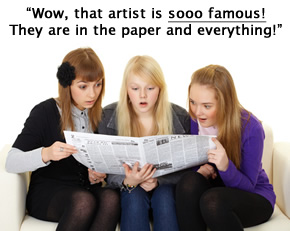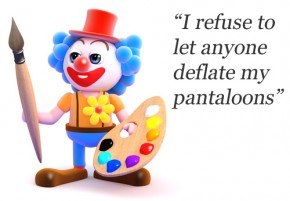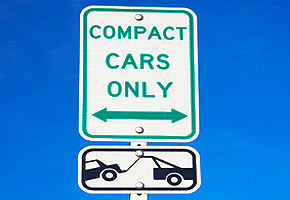You’ve created a brilliant artwork.
All your friends want it but of course they don’t want to part with the vast sums of money required to prise this gleaming jewel of paint and canvas from your hot little hands. They ask “is there a print available?”
The trouble is that making large high quality prints can a very expensive process, and full colour gloss inkjet prints from your MegaCorp Mutlifunction Centre can go through your printer cartridges quicker than a Hummer sucks a Gas Station dry. You need a cheap attractive alternative.
Have you thought about making Mini Art Prints?
What is a Mini Art Print?
In my case, the mini art prints I made were little full colour prints of my own artworks, no bigger than a business card, which I matted up, framed and subsequently sold to passing tourists at the markets. I personally signed and titled the mat of each print and popped them into neat little cellophane packages which looked irresistibly collectible. Since I had a series of artworks along a similar theme (Queenslander style houses in fact) this just added to the collectibility factor. You can make you prints bigger of course if you want to, but they are most economical if you keep them to around the size of a regular photograph or smaller.
Photography or scanning
In order to turn your artwork into a mini print you are first going to have to convert it into a digital picture of some kind, either through scanning for smaller works or photography for larger works. It’s important to know that the better the quality of the digital image of your artwork is, then the better your end result is going to be. You can’t skimp on this step or your print will look distinctly below par. Nobody wants a fuzzy, off-centre, strange coloured print no matter how astounding your original is. A photo taken with your common-or-garden domestic mid priced digital camera will be fine for creating mini prints, especially if you are a dab hand with Photoshop so you can crop it to size and give the colours a bit of a boost where needed to make the image really pop and sing.
Okay, so you’ve got yourself a digital image of your artwork. How do we print this thing?
Here’s the secret. Did you know that your local mega-electrical store or photo processing shop is a great source of high quality printing? Yes, really it is! New fangled digital photo printing kiosks are popping up in these establishments like mushrooms. Just pop your USB flash drive in and go. These machines do produce nice clear prints on real photographic paper and the quality is plenty good enough for reproducing art (in a mini way). Not only that, there’s often the bonus of choosing either a matt or gloss paper in a range of different size, at a price that’s very hard to beat.
Yes of course you could print your mini prints on your own high quality ink jet printer, but the cost per unit is way lower at a digital photo printing kiosk, and much faster if you are producing your mini prints in bulk quantities. You only have to contend with the strange looks from the Shop assistants who wonder why on earth you would print 100 photographs of the same thing.
“Archival Quality”
Now, before you scoff at the thought of creating an art print on photographic paper that you would actually sell to people, just think about it a bit. These machines can produce prints that will last potentially a very long time. In my local electrical superstore the Fuji paper that they use in their digital photo printer kiosk has a spec that is designed to last for around 70 years. I was downright cynical about these claims so I decided to do a little test for myself and took a sample photographic print and stuck it in the front window of my studio. It was exposed to the full on heat of the Australian sun for three weeks. Afterwards I examined the results and was surprised to find that fading was almost negligible, when compared to a ‘non exposed equivalent’.
Off to market we go
Feeling confident of the product I then had some little frames specially made up in which to mount my mini prints and set off to the local tourist market to sell my wares. I did quite well with them for a while. I enjoyed those art market days, though all that lugging about of tables nearly did my back in on a number of occasions. You can’t beat it though for direct customer sales experience though. 😉
To Frame or not to Frame…that is the question
You don’t have to go the full hog and mount your mini prints in frames. I’ve seen other artists do similar things and just mount them on a single mat with a backing, wrapped in cellophane to complete the package. It makes for a quite attractive as a little gift item. Custom sized mini mats and backings can be purchased quite cheaply in bulk from a picture framing shop, but make sure you go to a framer with an automated mat cutting machine.
Things to watch out for
Some older style digital photo printing kiosks produce prints that look a bit washed out and green. Avoid. Go to a shop with the latest technology installed if you can.
Also, remember that these machines are calibrated mainly to make happy snaps of people look good. Reds may look richer, blues may look bluer, greens might glow more. This is all designed to give people the illusion that the beach holiday they’ve just returned from was more of a paradise than they remembered when they photographed it. Do a test first before submitting a large print run.












By accident (or faith) I bumped into your web site while searching for ways to market my 2 x 2 inches collages/montages.
Your site’s helpful in giving me newer and up to the minutes ideas on how to market my work.
Thanks, you’re on my list of favorites now.
Sam
Creating mini art prints is a great idea and could be used for marketing. Thanks for the post.
David
Great site! I wonder, would it be okay to use this idea for A4 prints of my work. The origionals are all A3 on canvasboard and I take and tweek good photos..
The bigger you print the better the quality photos you have to take. You might be ok with a4. Worth a try.
Thank you, this was just the type of advice I was seeking.
I love this site, thanks for all the great articles.
YOU POST ALL THESE ARTICLES AND NEVER PUT ANY PICTURES OF YOUR ART..>WHERE CAN PEOPLE SEE YOUR ART?
JUST MAKING ME VERY CURIOUS!!
Click the ‘My Art’ link at the top of this page. 😉 Turn off your CAPS LOCK, and enjoy the show B-) lol
lol, thats FUNNY!